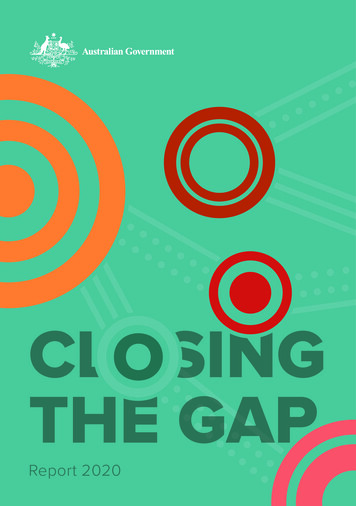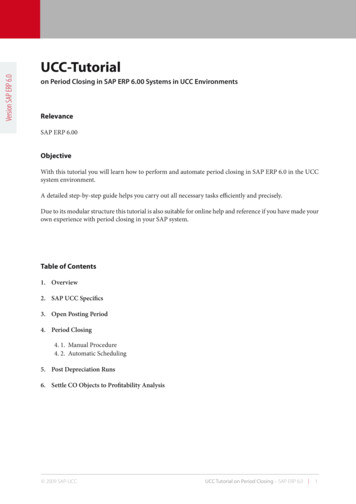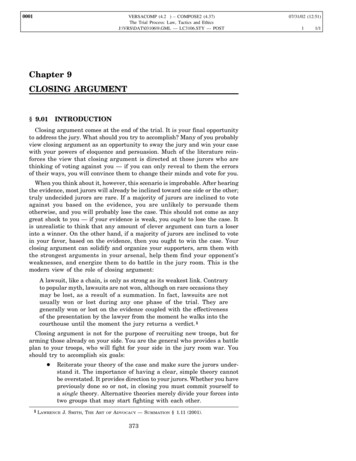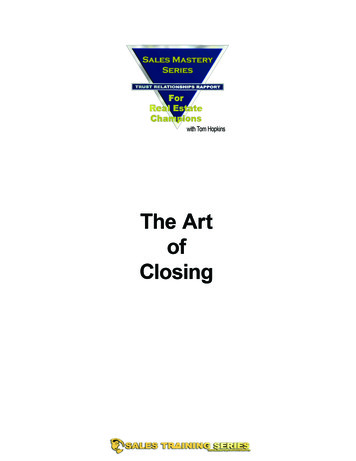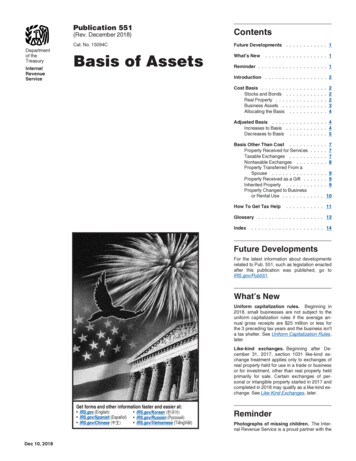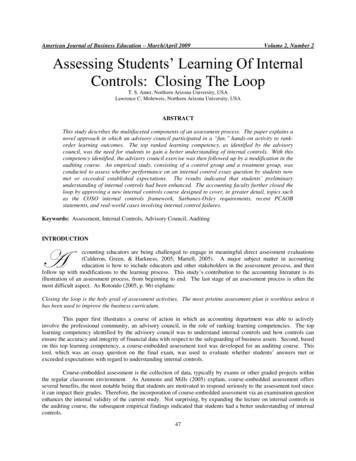
Transcription
American Journal of Business Education – March/April 2009Volume 2, Number 2Assessing Students’ Learning Of InternalControls: Closing The LoopT. S. Amer, Northern Arizona University, USALawrence C. Mohrweis, Northern Arizona University, USAABSTRACTThis study describes the multifaceted components of an assessment process. The paper explains anovel approach in which an advisory council participated in a “fun,” hands-on activity to rankorder learning outcomes. The top ranked learning competency, as identified by the advisorycouncil, was the need for students to gain a better understanding of internal controls. With thiscompetency identified, the advisory council exercise was then followed-up by a modification in theauditing course. An empirical study, consisting of a control group and a treatment group, wasconducted to assess whether performance on an internal control essay question by students nowmet or exceeded established expectations. The results indicated that students’ preliminaryunderstanding of internal controls had been enhanced. The accounting faculty further closed theloop by approving a new internal controls course designed to cover, in greater detail, topics suchas the COSO internal controls framework, Sarbanes-Oxley requirements, recent PCAOBstatements, and real-world cases involving internal control failures.Keywords: Assessment, Internal Controls, Advisory Council, AuditingINTRODUCTIONAccounting educators are being challenged to engage in meaningful direct assessment evaluations(Calderon, Green, & Harkness, 2005; Martell, 2005). A major subject matter in accountingeducation is how to include educators and other stakeholders in the assessment process, and thenfollow up with modifications to the learning process. This study’s contribution to the accounting literature is itsillustration of an assessment process, from beginning to end. The last stage of an assessment process is often themost difficult aspect. As Rotondo (2005, p. 96) explains:Closing the loop is the holy grail of assessment activities. The most pristine assessment plan is worthless unless ithas been used to improve the business curriculum.This paper first illustrates a course of action in which an accounting department was able to activelyinvolve the professional community, an advisory council, in the role of ranking learning competencies. The toplearning competency identified by the advisory council was to understand internal controls and how controls canensure the accuracy and integrity of financial data with respect to the safeguarding of business assets. Second, basedon this top learning competency, a course-embedded assessment tool was developed for an auditing course. Thistool, which was an essay question on the final exam, was used to evaluate whether students’ answers met orexceeded expectations with regard to understanding internal controls.Course-embedded assessment is the collection of data, typically by exams or other graded projects withinthe regular classroom environment. As Ammons and Mills (2005) explain, course-embedded assessment offersseveral benefits, the most notable being that students are motivated to respond seriously to the assessment tool sinceit can impact their grades. Therefore, the incorporation of course-embedded assessment via an examination questionenhances the internal validity of the current study. Not surprising, by expanding the lecture on internal controls inthe auditing course, the subsequent empirical findings indicated that students had a better understanding of internalcontrols.47
American Journal of Business Education – March/April 2009Volume 2, Number 2METHODOLOGY AND DATA COLLECTIONThe assessment study was conducted at an AACSB-accredited business school located in the Southwestoffering undergraduate and MBA business degrees. The College expects all business majors to developcompetencies in the areas of written and oral communication, analytical skills, ethics, and self-management. Inaddition to these generic competencies, the accounting department faculty identified ten additional functionalcompetencies that an accounting major is expected to have when completing the program. These ten competenciesare listed in Table 1 in no specific order.1Table 1: Ten Things That an Accounting Major Should Know1.2.3.4.5.6.7.8.9.10.Prepare financial statements that are consistent in form & content with current professional standardsUnderstand GAAPApply accounting concepts & principles in practiceUse technology appropriately to research and analyze and/or solve accounting problemsUnderstand internal controls & how controls can ensure the accuracy & integrity of financial data & safeguarding ofbusiness assetsAnalyze systems & identify the functions for each technology component in a system; design & implementappropriate control systems for each componentUnderstand the role auditing plays in promoting the free flow of reliable informationComprehend the content, structure, & meaning of reporting for internal operations, & apply the concepts to createaccounting reports & design management planning & control systemsUnderstand the role of taxation in business & personal decision-making processesUnderstand current accounting theory & the approaches to its developmentWhile generic skills are important, the advisory council’s focus was on the functional competencies that anaccounting major is expected to have when completing the program. At the annual spring accounting advisorymeeting participants engaged in an exercise to identify the importance of the aforementioned ten competencies.Each competency was written on flip charts which were randomly distributed around the meeting room. Tenprofessionals, seven faculty members, and one student were each given four “P” dots and 4 “I” dots. The “P”represented public accounting and “I” represented industry. The participants then went around the room and placedtheir allotment of dots on what they considered to be the most important competencies. The professionals consistedof two audit partners (“Big 4” and a national CPA firm), two audit managers (one “Big 4” and the other from thestate’s Auditor General office), one attorney, one sole practitioner, one chief financial officer, one CPA executivefrom the State’s Society of CPAs, one internal audit director, and one controller. Table 2 shows the results.The accounting advisory council members found the activity to be an innovative and inspiring way toinvolve panel members in the assessment process. Elicitation of professionals’ views with respect to rank orderingthe ten competencies provided the accounting faculty with a unique perspective on their perceived importance to thebusiness community. In addition, this procedure touched on some important broad principles related to assessment.For example, as Apostolou (1999, p.179) states: Assessment fosters wider improvement when representatives from across the educationalcommunity are involved, andAssessment makes a difference when it begins with issues of use and illuminates questions thatpeople really care aboutFrom Table 2 it is easy to ascertain that understanding internal controls was the learning competency thatemerged as most important. With the leading learning competency identified, a final exam essay question wasdeveloped. As shown in Table 3 this essay question contained three parts. Parts II & III of the essay question wereadapted and modified from Messier, Glover & Prawitt (2006).48
American Journal of Business Education – March/April 2009Volume 2, Number 2Table 2: Evaluation of Functional Competencies(Each person had 4 "P" dots & 4 "I" dots)Functional CompetencyUnderstand internal controls & how controlscan ensure the accuracy & integrity offinancial data & safeguarding of businessassetsUnderstand GAAPPrepare financial statements that areconsistent in form & content with currentprofessional standardsUse technology appropriately to research andanalyze and/or solve accounting problemsComprehend the content, structure, &meaning of reporting for internal operations,& apply the concepts to create accountingreports & design management planning &control systemsAnalyze systems & identify the functions foreach technology component in a system;design & implement appropriate controlsystems for each componentUnderstand the role auditing plays inpromoting the free flow of reliableinformationApply accounting concepts & principles inpracticeUnderstand the role of taxation in business &personal decision-making processesUnderstand current accounting theory & theapproaches to its developmentAAC Members(n 10)dark blue dotsPublicIndustryFaculty (n 7)yellow dotsPublicIndustryStudent (n 1)light blue trol GroupIn order to establish a baseline of student understanding of internal controls and determine if animprovement in this understanding was attained, an essay question was included on the final exam of the auditingcourse during the fall of 2005. The auditing course is a required course for all accounting majors seeking anemphasis in “public accounting.” The essay question, which contains three parts, is shown in Table 3. The first partrequired an objective answer pertaining to the definition and objectives of a system of internal controls. The secondpart required each student to apply the principles of internal controls to a specific transaction processing system, theexpenditure cycle. The third part of the question required analysis, in that students’ were requested to identify theconsequences of internal control weaknesses in the expenditure cycle.Treatment ConditionIn the spring 2006 auditing class the curriculum was modified to include an extended lecture on internalcontrols in the expenditure cycle. The objective of providing additional coverage was to enhance students’understanding of internal controls and to close the loop, so to speak, on any deficiencies in their learning outcomes.The extended lecture included more discussion of understanding the dimensions and the definition of internalcontrols, as well as a greater emphasis on appreciating what key duties and jobs need to be segregated.49
American Journal of Business Education – March/April 2009Volume 2, Number 2Table 3: Essay Question – Internal ControlsQuestions:Part I: Define internal control and the objectives of a system of internal controlsPart II: List the key segregation of duties in the expenditures cycle – the request, ordering, and payment for merchandiseinventoryPart III: What errors or fraud can occur if the duties in the expenditure cycle are not segregated?Suggested Answers:Part I: Internal control is the set of policies and procedures developed to ensure the safeguarding of an entity’s assets, thereliability of its accounting records, and the accomplishment of overall company objectives. The objectives of a system ofinternal controls are to provide reasonable assurance regarding Part II: Reliability of financial reportingEffectiveness and efficiency of operationsCompliance with applicable laws and regulationsThe purchasing function should be segregated from the requisitioning and receiving functions The invoice-processing function should be segregated from the accounts payable function The disbursement function should be segregated from the accounts payable function The accounts payable function should be segregated from the general ledger functionPart III: Theft of goodsPossible payment for unauthorized purchasesTheft of cashOverpayment for goods and servicesA defalcation that would normally be detected by reconciling subsidiary records with the general ledger controlaccountScoring the Examination Questions – Independent VariableA total of 21 students completed the fall 2005 auditing course, took the final examination and provided ananswer to the internal control essay question. In the spring, 2006 auditing course, a total of 26 students completedand provided an answer to the internal control question on the final examination. To enhance internal validity in thescoring of the internal control questions, the 47 student responses were photocopied and randomly sorted using arandom number table. In addition, the student names did not appear on any of the photocopied responses.Therefore, when scoring the essay questions, the evaluators did not know if the question responses were from thecontrol or from the treatment groups.2 This provided a reasonable control against bias in the scoring of the studentresponses and supports a reasonably clean assessment of the effect of the treatment condition on student learning.Each part of the three-part essay question was subsequently evaluated independently by two accountingeducators using the rubric as described in Table 4. Using agreed-upon rubrics is recognized by the AACSB as aneffective approach to evaluate learning competencies for assessment purposes (Calderon, Green, & Harkness, 2005).50
American Journal of Business Education – March/April 2009Volume 2, Number 2Evaluator #1 was an accounting educator who did not teach the auditing course, but nevertheless had an in-depthunderstanding of internal controls. Evaluator #2 was the instructor of the auditing course.Table 4: Assessment RubricBelow Expectations1Identifies fraudprevention as a goal andlists no objective.Meets Expectations2Identifies management’srole and lists oneobjective.Exceeds Expectations3Identifies management’srole and lists two or moreobjectives.List the key segregation of duties inthe expenditures cycle – therequest, ordering, and payment formerchandise inventoryIdentifies the segregationof no or one pair offunctional areas.Identifies the segregationof two pairs of functionalareas.Identifies the segregationof more than two pairs offunctional areas.What errors or fraud can occur ifthe duties in the expenditure cycleare not segregatedIdentifies no or one erroror fraud.Identifies two errors orfraud.Identifies more than twopossible errors or fraudand links the errors orfraud to the functionalpair that should besegregated.Define internal control and theobjectives of a system of internalcontrolsEach evaluator assigned a score on a three part scale. A score of “1” was assigned if the student did not“meet expectations” of that expected of someone with an understanding of internal controls (i.e., the student did notanswer the question correctly as specified by the criteria in the rubric). A score of “2” was assigned if the student“met expectations” of someone with an understanding of internal controls (i.e., the student answered the questionmostly correct as specified by the criteria in the rubric). A score of “3” was assigned if the student “exceededexpectations” of someone with an understanding of internal controls (i.e., the student provided an excellent answer –completely correct).After independently scoring the 47 student responses, the two evaluators convened to discuss anydifferences in the resulting scores. Where differences occurred between the evaluators, the individual student’sresponse was examined and rescored so that a consensus score was applied to the response. The frequencies ofagreement between the two evaluators were 77%, 59%, and 66% for parts (1), (2), and (3), respectively. Moreimportantly, the statistical analysis performed on the data set generated from each evaluator was consistent with theconsensus results as reported in Table 5.RESULTSTable 5 displays the results of student performance on the internal control question across both semesters;fall semester (control group) and spring semester (treatment group). The data displays the number andcorresponding percentage of students’ scores at each of the three performance levels (below expectations, meetsexpectations, and exceeds expectations) on each of the three parts of the essay question.When viewing the data in the top part of Table 5 we found the results of the fall semester (control group)somewhat discouraging. Only 29% of the students met expectations on the first part of the essay question and nostudents exceeded expectations.3Performances on the other two parts of the question were better, in that about 75% of the students met orexceeded expectations. This divergence of results is interesting in that most students could not well articulate thedefinition or objectives of a system of internal controls (the answer required for part (1) of the essay question), butthey could describe which controls should be in place within the expenditure cycle.51
American Journal of Business Education – March/April 2009Volume 2, Number 2Table 5: Results of Assessment Evaluations – Number (%) of StudentsScored at Each Performance LevelPart 1Question PartPart 2Part 3Fall Semester – Control (n 21)Below ExpectationsMeets ExpectationsExceeds ExpectationsSpring Semester – Treatment (n 26)Below ExpectationsMeets ExpectationsExceeds Expectations15 (71%)6 (29%)0 ( 0%)5 (24%)14 (67%)2 ( 9%)6 (28%)14 (67%)1 ( 5%)1 ( 4%)9 (35%)16 (61%)5 (19%)11 (42%)10 (39%)6 (23%)18 (69%)2 ( 8%)Key:1 - Did not meet expectations, i.e., did not answer the question(s) correctly2 - Met expectations, i.e., pretty much answered the question(s) correctly3 - Exceeded expectations, i.e., gave an excellent answer – completely correctComparing the percentages between the fall semester students (control group) and the spring semesterstudents (treatment group) indicates a performance improvement, at least on the first two parts of the essay question.For part (1), performance increases showed that 96% of the students met or exceed expectations. For part (2),performance increases showed that 81% of the students met or exceed expectations. Most of the increase inperformance for part (2) resulted from a higher proportion of students who exceeded expectations (from 9% to39%). The data in Table 5 indicates little difference in performance across groups for part (3) of the essay question.A binomial z-test was carried out on the data and revealed statistically significant performance changes (p .05) across groups for the student responses to part (1) and part (2) of the essay question.4 Specifically, thepercentage of students who scored below expectations for part (1) declined from 71% to 4%, while the percentage ofstudents who exceeded expectations on part (1) increased from 0% to 61%. For part (2) of the essay question thepercentage of students who exceeded expectations increased from 9% to 39%. No statistical difference wasdiscovered for student performance on part (3) of the essay question.LIMITATIONS AND CONCULSIONSThe assessment process that we describe is indeed multifaceted. Input was obtained from professionalaccountants serving on an advisory board and, based on this input the curriculum pertaining to internal controls wasmodified in an auditing course. In addition, performance by students was assessed. Our empirical findings onlyprovide preliminary evidence that may be used to close the loop on assessment. While the interventions weimplemented were time consuming and costly, especially when considering the opportunity costs of the professionalaccountants serving on the accounting area's advisory council, they must be viewed in the context of continuousimprovement necessary for a more robust assessment.Modifying the auditing course was the first stage of the assessment process. The final closing the loop tookplace when a new internal auditing & controls course was offered in the spring 2008 semester. This new coursecovered internal controls topics in depth. The course used an internal auditing textbook, published by the Instituteof Internal Auditors (Reding, et. al., 2007), a case book by Michael Knapp (2006), and a paperback titled “SarbanesOxley for Dummies” by Jill Welytok (2006). As Calderon, Green, & Harkness (2005, p. 282) explains:52
American Journal of Business Education – March/April 2009Volume 2, Number 2The final part of the process – using the evidence to initiate learning improvement opportunities – closes the loop.This process of closing the loop means that the program has completed all fundamental activities in the assessmentprocess and is now ready to employ the evidence to initiate course and curriculum changes. Closing the loopaddresses the most fundamental goal of assessment – it assures that assessment leads to program improvement.The findings from the essay test showed that there was some improvement in students’ understanding ofinternal controls. However, a limitation of the empirical test is that it only “scratches the surface” of understandinginternal controls. The key evidence to initiate learning improvement, especially the driving force to develop a newcourse, was the overall input that was obtained from professional accountants serving on an advisory board.Feedback from experts on assessment suggests that it can be a real challenge to overcome faculty resistanceto assessment (Martell, 2005). In this setting, our primary contribution lies in documenting the multifacetedcomponents fundamental to the assessment process to enhance curriculum improvements.NOTES1234Ammons and Mills (2005, p. 5) argue that instead of objectives that use verbs like “understand” or “appreciate,”objectives will provide a better basis for assessment if they use observable descriptions of learning outcomes withaction verbs like “calculate,” “categorize,” “compare,” or “construct.”The same essay question included on the fall, 2005 final examination, and shown in Table 3, was included on thefinal examination for the students enrolled in the spring, 2006 course. The final examinations administered duringthe fall, 2005 semester were not returned to students in order to prevent knowledge transfer of the question tostudents enrolled during the spring, 2006 semester. Students in both semesters automatically received full creditfor this essay question to ensure fairness for all students. Not grading this question allowed clean and unmarkedphotocopies of students’ answers to be available for the evaluators. Using the identical question in the springallowed a comparison of student performance as a result of the treatment condition.A question often asked by educators is what percentage of students must meet, or exceed, expectations in order tobe satisfied that standards are being met. The Association to Advance Collegiate Schools of Business (AACSB)provides this guideline: “One emphasis in the Assurance of Learning Standards is to gather data on studentlearning to be used for the purposes of improving business curricula. For each learning goal, the school’s facultywill determine its minimum expectation or standard. There is no prescribed percentage of students that must meetthe standards articulated by the faculty. What the review team will be looking for, instead, is how these data areused. Thus, a poor showing on student mastery of a learning goal (e.g., analytical reasoning) would only be aconcern if the curriculum was not subsequently modified to improve student skills in this area. A second purposefor the learning goals is to communicate the competencies of graduates to students and employers. Thus, thegoals should represent learning goals achieved by nearly all graduates, not just a portion. The review team willalso examine whether the school’s performance standards are appropriate given the student body demographicsand the school’s mission.” (see: www.aacsb.edu/resource centers/assessment/frequently-asked.asp).Could the results be driven by the possibility that students in the spring course were better students then thoseenrolled in the previous fall semester course? To eliminate this alternative explanation, we examined final examscores without the essay question. Final exams were not distributed back to students and the same exam was usedin both the fall (control) and spring (treatment) semester. The mean, variance, and median for the control versustreatment groups were 66.2, 148.0, 70, and 63.0, 123.6, 65, respectively. Results from a t-test on the final examscores indicated that there was no significant difference between the two classes (p .38).AUTHOR INFORMATIONT. S. Amer is a Professor of Accounting at The W. A. Franke College of Business at Northern Arizona University.He holds a Ph.D. from The Ohio State University.Lawrence C. Mohrweis is a Professor of Accounting at The W. A. Franke College of Business at Northern ArizonaUniversity. He holds a Ph.D. from the University of Wisconsin – Madison.53
American Journal of Business Education – March/April 2009Volume 2, Number 2REFERENCES1.2.3.4.5.6.7.8.9.Ammons, J. L., & S. K. Mills. 2005. Course-embedded assessments for evaluating cross-functionalintegration and improving the teaching-learning process. Issues in Accounting Education: 1-19.Apostolou, B.A. 1999. Outcomes assessment. Issues in Accounting Education: 177-197.Calderon, T, B. P. Green, and M. Harkness. 2005. Best practices in accounting program assessment:Executive summary, AAA teaching and curriculum committee on best practices in accounting programassessment. Pp. 277-306. Advances in Accounting Education: Teaching and Curriculum Innovations, vol.7, edited by Bill N. Schwartz and J. Edward Ketz. Elsevier: JAI.Knapp, M. C. 2006. Contemporary Auditing: Real Issues & Cases, Mason, OH: Thomson South-Western,IncMartell, K. 2005. Overcoming faculty resistance to assessment. Pp. 210-226. Assessment of studentlearning in business schools: Best practices each step of the way, vol. 1, no. 2, edited by Kathryn Martelland Thomas Calderon. Tallahassee, FL: The Association for Institutional Research.Messier, Jr., W. F., S. M. Glover, D. F. Prawitt. 2006. Auditing & assurance services: A systematicapproach. New York, N.Y.: McGraw-Hill Irwin.Reding, K. F., P. J. Sobel, U. L. Anderson, M. J. Head, S. Ramamooriti, M. Salamasick. 2007. InternalAuditing: Assurance & Consulting Service, Altamonte Springs, FL: The Institute of Internal AuditorResearch Foundation.Rotondo, D. M. 2005. Assessing business knowledge. Pp. 82-103. Assessment of student learning inbusiness schools: Best practices each step of the way, vol. 1, no. 1, edited by Kathryn Martell and ThomasCalderon. Tallahassee, FL: The Association for Institutional Research.Welytok, J. G. 2006. Sarbanes-Oxley for Dummies, Hodoken, New Jersey: Wiley Publishing, Inc.54
loop by approving a new internal controls course designed to cover, in greater detail, topics such as the COSO internal controls framework, Sarbanes-Oxley requirements, recent PCAOB statements, and real-world cases involving internal control failures. Keywords: Assessment, Internal Controls, Advisory Council, Auditing INTRODUCTION A




